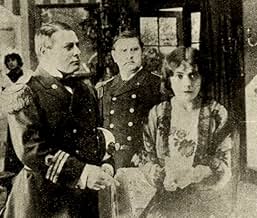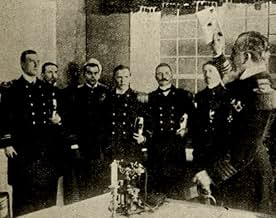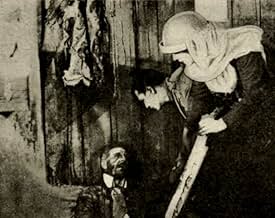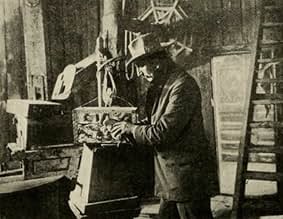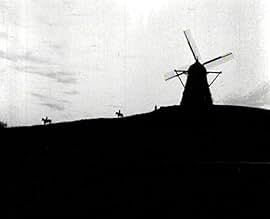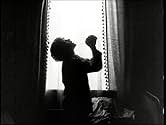Aggiungi una trama nella tua linguaOn the brink of war, Lt. van Hauen is summoned to take command of the cruiser, but due to unforeseen events, he is wrongfully convicted as a traitor.On the brink of war, Lt. van Hauen is summoned to take command of the cruiser, but due to unforeseen events, he is wrongfully convicted as a traitor.On the brink of war, Lt. van Hauen is summoned to take command of the cruiser, but due to unforeseen events, he is wrongfully convicted as a traitor.
- Regia
- Sceneggiatura
- Star
Recensioni in evidenza
When you look well into the past of cinema, what you usually get are historically significant films, and that isn't absolutely a synonym for good films. Well here's one you may want to watch simply for the fact that it is good.
Sealed orders is Christiansen's first film (a man I only know for the film "Haxan")and it is war drama at it's best. Tragic twist of fate, clear storyline, good pacing and great lighting work. It's a few years in advance on it's time, but it isn't technical wonders of the cinema of the 20s or of now. It's still theatrical, though it isn't anything like the early films of it's time and before. The film survived to our days in a great condition, nothing like the jerky pictures moving at a wrong speed we like to think of.
To put it simply, you'll watch it and have a great time, as long you like dramas of this kind. But if you actually cared enough to read a IMDb review of a 1914 film, It's surely your kind.
Sealed orders is Christiansen's first film (a man I only know for the film "Haxan")and it is war drama at it's best. Tragic twist of fate, clear storyline, good pacing and great lighting work. It's a few years in advance on it's time, but it isn't technical wonders of the cinema of the 20s or of now. It's still theatrical, though it isn't anything like the early films of it's time and before. The film survived to our days in a great condition, nothing like the jerky pictures moving at a wrong speed we like to think of.
To put it simply, you'll watch it and have a great time, as long you like dramas of this kind. But if you actually cared enough to read a IMDb review of a 1914 film, It's surely your kind.
A tale of injustice and redemption at the onset of the First World War. Fascinating glimpse into the distant past.
10poulbro
A wonderful silent film! This is one of the most innovative silent films ever. The danish director Benjamin Christensen made his director debut with this film that he financed himself. With his own company Dansk Biografkompagni, he started filming this film, that he wrote over one night. The plot in the film is good but not great. What makes this film so interesting is how Benjamin Christensen used darkness vs. light to create an atmosphere. Before this film a lack of light was considered as a lack of talent, but Benjamin proved that shadows can be very effective.
A great film
A great film
This film, directed by Benjamin Christensen is regarded by many who have seen it as one of the greatest directorial debuts in cinema history. The Museum of Modern Art in New York houses a print of the film, without subtitles which makes it hard to follow at times, and not even a title or credits sequence, if the film ever had one. Two years ago, MOMA had a wonderful tribute to Christensen in which they screened all of his surviving films. This one is one of his two or three most important and one has to keep reminding his or herself that this is his FIRST film at a time when motion pictures were not even twenty years old!
Christensen is credited with being the first filmmaker to consciously shoot into direct light, creating silhouettes and magnificent compositions. He doesn't waste any time in this film, dazzling the audience with (at the time) very complicated lighting set-ups involving sunsets and characters lighting up a lamp in a rooms of darkness. Indeed this film was made two years before "Birth of a Nation" and artistically is just as good as that film and in some ways better.
It would be hard to assess if Christensen was the first to achieve the great things he accomplished since so much early cinema is lost, but there is no doubt that he had a mastery of lighting and composition, and for such an early filmmaker it is truly astounding. Very few of his films are available to the public, but the few that are findable (Mockery, Seven Footprints to Satan, and Witchcraft Through the Ages) are all cinematically interesting and at times downright fascinating.
Christensen is credited with being the first filmmaker to consciously shoot into direct light, creating silhouettes and magnificent compositions. He doesn't waste any time in this film, dazzling the audience with (at the time) very complicated lighting set-ups involving sunsets and characters lighting up a lamp in a rooms of darkness. Indeed this film was made two years before "Birth of a Nation" and artistically is just as good as that film and in some ways better.
It would be hard to assess if Christensen was the first to achieve the great things he accomplished since so much early cinema is lost, but there is no doubt that he had a mastery of lighting and composition, and for such an early filmmaker it is truly astounding. Very few of his films are available to the public, but the few that are findable (Mockery, Seven Footprints to Satan, and Witchcraft Through the Ages) are all cinematically interesting and at times downright fascinating.
This looks like a first film, and, of course, it's the directorial début of Benjamin Christensen, whose place in film history rests mostly upon "Häxan" ("Witchcraft Through the Ages"), his third motion picture. This one does not have a distinctive style, not as "Häxan" or "Blind Justice" (Hævnens nat), his second picture, would. Yet, this is common; most filmmakers begin not with their own designs and ideas, but rather copy (to greater extent than usual and to less effect) from those who came before them. What Christensen copies, then, is where this shows promise.
At this time, in the early 1910s before "The Birth of a Nation", Danish cinema was perhaps the best in the world, so Christensen had much to work with. From what I've seen, mise-en-scène was especially developed. From a historical perspective, the lighting effects in Danish cinema were remarkable, influencing Weimar cinema and, thus, American film noir. There are such examples here. None of it seems especially original, but represents the best that others had previously used: low-key lighting for dramatic effect, stunning silhouettes and diegetic, or seemingly diegetic, lighting. Some scenes are only lit by the sunlight coming through a widow or door, or from a flashlight. Others seem as though they're lit by diegetic sources, such as a lamp or from turning on a light switch. Generally, this was done by stopping filming after a character flipped a switch, then the lighting scheme for the scene was setup and filming resumed, to later be touched up by editing. Objects often partially hide the characters, and the original darkness also helps to cover this effect, but if you look closely, you can sometimes notice the cut.
Furthermore, mirrors figure prominently in some scenes, as they do elsewhere in Danish pictures. Early on, Danish filmmakers weren't too concerned with narratives, but by the time of this one, they were becoming more complex. "Häxan" is something of a pinnacle. "Sealed Orders", or "Orders Under Seal", "The Mysterious X" (Det Hemmelighedsfulde X)--whatever you want to call this film--has a more-traditionally-engaging story. It takes from the sensational genre, a uniquely Scandinavian type of picture, with the cheating wife, scandals, being trapped in a cellar and the convoluted suspense. It was sold as such (see the tagline), but it's also simply a melodrama. The last-minute rescue might even owe something to the American director D.W. Griffith.
This isn't entirely promising stuff to work with, but it's a fine beginning, and Christensen would go on to demonstrate his skill. "Sealed Orders" contains plenty of errors: jump cuts, theatrical long shots and the obvious daytime photography near the end for what's supposed to be nighttime in the story. Perhaps the tinting or something was lost for the print I saw, but Griffith and Bitzer rectified this problem in "The Birth of a Nation" by filming at night, and Christensen would do the same for "Häxan". Still, this is a promising début.
At this time, in the early 1910s before "The Birth of a Nation", Danish cinema was perhaps the best in the world, so Christensen had much to work with. From what I've seen, mise-en-scène was especially developed. From a historical perspective, the lighting effects in Danish cinema were remarkable, influencing Weimar cinema and, thus, American film noir. There are such examples here. None of it seems especially original, but represents the best that others had previously used: low-key lighting for dramatic effect, stunning silhouettes and diegetic, or seemingly diegetic, lighting. Some scenes are only lit by the sunlight coming through a widow or door, or from a flashlight. Others seem as though they're lit by diegetic sources, such as a lamp or from turning on a light switch. Generally, this was done by stopping filming after a character flipped a switch, then the lighting scheme for the scene was setup and filming resumed, to later be touched up by editing. Objects often partially hide the characters, and the original darkness also helps to cover this effect, but if you look closely, you can sometimes notice the cut.
Furthermore, mirrors figure prominently in some scenes, as they do elsewhere in Danish pictures. Early on, Danish filmmakers weren't too concerned with narratives, but by the time of this one, they were becoming more complex. "Häxan" is something of a pinnacle. "Sealed Orders", or "Orders Under Seal", "The Mysterious X" (Det Hemmelighedsfulde X)--whatever you want to call this film--has a more-traditionally-engaging story. It takes from the sensational genre, a uniquely Scandinavian type of picture, with the cheating wife, scandals, being trapped in a cellar and the convoluted suspense. It was sold as such (see the tagline), but it's also simply a melodrama. The last-minute rescue might even owe something to the American director D.W. Griffith.
This isn't entirely promising stuff to work with, but it's a fine beginning, and Christensen would go on to demonstrate his skill. "Sealed Orders" contains plenty of errors: jump cuts, theatrical long shots and the obvious daytime photography near the end for what's supposed to be nighttime in the story. Perhaps the tinting or something was lost for the print I saw, but Griffith and Bitzer rectified this problem in "The Birth of a Nation" by filming at night, and Christensen would do the same for "Häxan". Still, this is a promising début.
Lo sapevi?
- QuizShot over the course of three months.
- Versioni alternativeFor the film's release in Germany, all references to spies were eliminated, as any references to spies were expressly forbidden by the government censors. The spies in the film were turned, via the intertitles, into smugglers.
I più visti
Accedi per valutare e creare un elenco di titoli salvati per ottenere consigli personalizzati
Dettagli
- Tempo di esecuzione1 ora 24 minuti
- Colore
- Mix di suoni
- Proporzioni
- 1.33 : 1
Contribuisci a questa pagina
Suggerisci una modifica o aggiungi i contenuti mancanti

Divario superiore
By what name was Det hemmelighedsfulde X (1914) officially released in Canada in English?
Rispondi
